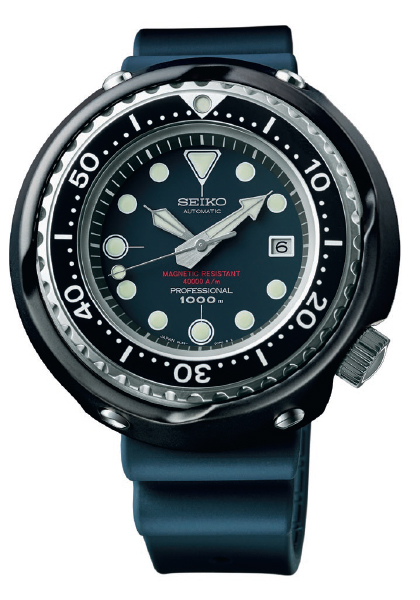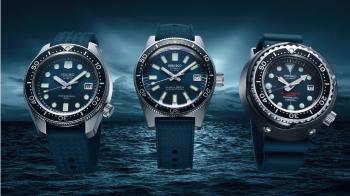With its distinct form factor, there is no doubting the iconic status of Seiko’s third historical dive watch — the 52mm-diameter Professional 600M unveiled in June 1975. Coupled with its metallic bezel, this unique monocoque or single-piece case construction dive watch that has an opening only from the front is likened to canned tuna. Such an uncanny resemblance, pun unintended, led collectors to affectionately nickname the Professional 600M Dive watch the "tuna can".
The Seiko Tuna has become a classic; almost half a century later, evolved variants continually secure the model’s place in the brand’s contemporary collection simply because they remain bestsellers. The Seiko Tuna has a separate outer conical body known as the shroud acting as a protective layer and is precisely fitted over the inner case. Its large overall diameter of around 52mm is a key characteristic, as smaller 43mm-diameter versions are known as the Baby Tuna.
SLA041 “The 1975 Professional Diver’s 600m Re-creation” and SLA042, a nominee in the 2020 Grand Prix d’Horlogerie de Genève (GPHG), are reincarnations of the Tuna found in Seiko’s Prospex collection of sports watches that meet the brand’s demanding quality standards. Prospex is an apt portmanteau, derived from the words “professional” and “specifications”.
In March 2020, Seiko staked its claim to the world’s first use in the watch industry of what it terms “Ever-Brilliant Steel” for the cases of its SLA037 and SLA039 dive watches — both of which are re-editions of its first- and second-generation dive watches, the Professional 150M of 1965 and Professional 300M of 1968 respectively. “Ever-Brilliant Steel” has a PREN, the acronym for Pitting Resistance Equivalent Number — the industry measure for corrosion resistance — that is 1.7 times more than stainless steel grades used in the majority of luxury watches. This durable material has a brilliant white hue and is widely used in the marine industry, notably on surfaces, linings, bolts and multiple components of marine structures and vessels.

Constant Evolution
For the SLA041, the re-edition of its third generation 600m dive watch, “Ever-Brilliant Steel” is used only on its bezel as Seiko has stayed true to its original titanium body. One must not forget that back in 1975, the use of titanium for the case of a dive watch case was a world’s first. Titanium is strong, corrosion-resistant and lightweight.
While there was a three-year interlude between the launch of Seiko’s first-ever dive watch and the second-generation model, it was a seven-year wait before the Professional 600M saw the light of day, with the brand wanting to meet the demands of professional divers.
The catalyst that sparked the Professional 600M project was a written complaint by Yo Oshima, a diver in Kure City, Hiroshima and employed by Nihon Kaiyo Sangyo that is today known as Sumitomo Marine Development. Oshima’s critical feedback of 1968 was the scathing proclamation that the Professional 300M was “unfit for use”.
This was literally a bolt out of the deep blue sea. The second-generation Professional 300M was about a year old and its water-resistance to 300 metres or about 1,000 feet was double that of its predecessor, the Professional 150M, because of an innovative one-piece construction method not even previously witnessed in Swiss-made designs, as well as the use of hardened inorganic glass.
Seiko’s developers sought constructive feedback from Oshima, a professional saturation diver from a drillship who made descents and ascents in a pressurised diving bell to work at depths of around 350 metres. Seiko’s development team members even visited the drillship Oshima worked from to better understand the environment and the issues saturation divers faced with their watches. The problems included magnetised watches, as electrical welding was performed underwater, poor legibility under dim conditions, malfunctioning movements in the decompression chamber, as well as detached crowns due to accidental impacts.
This explains the use of an anti-magnetic sheet between the base of the watchcase and the movement, large luminescent circular hour-markers, a triangular hour-marker at 12 o’clock as the reference, broad hours and minutes hands, a luminescent circular indicator on the sweep seconds hand, the brand’s most reliable movement at the time which was automatic Calibre 6159, the positioning of the crown at 4 o’clock and “black thermal spraying” — the application of hard coating material on the outer case body at high temperatures for added surface protection.
Seiko has persisted in the war against magnetism, using a pure iron dial on the SLA041 to increase its resistance to 40,000 amperes per metre.
Working at great depths, saturation divers typically breathe in a mixture of helium and oxygen. Helium will inevitably enter their watchcases. During ascent, helium gas build-up in the case that has not escaped may lead to overpressure, thereby causing the glass to crack or suffer a violent displacement. While Rolex created the helium escape valve to resolve this, Seiko found its own footing for its Professional 600M by crafting a watchcase that not only withstands pressurisation and decompression but is impermeable to helium. Among other things, this entailed the development of Seiko’s own L-shaped gaskets to seal the glass and the crown. This explains why Seiko Tuna dive watches, including the SLA041 rated to 1,000 metres, do not require the helium escape valve.
he Japanese proverb, 継続は力なり— pronounced keizoku wa chikara nari and meaning “continuance is power” — personifies Seiko’s unwavering quest for robust and reliable deep dive watches. Though deepsea divers are indeed a small segment, they are by no means inconsequential as their invaluable input has enabled Seiko to win even the hearts of the much larger and economically consequential worldwide market of “desk divers”.
This year GMT Magazine and WorldTempus have embarked on the ambitious project of summarising the divers watch since 2000 in The Millennium Watch Book - Divers watch, a big, beautifully laid out coffee table book. This article is an extract. The Millennium Watch Book - Divers watch is available in both French and English here:





